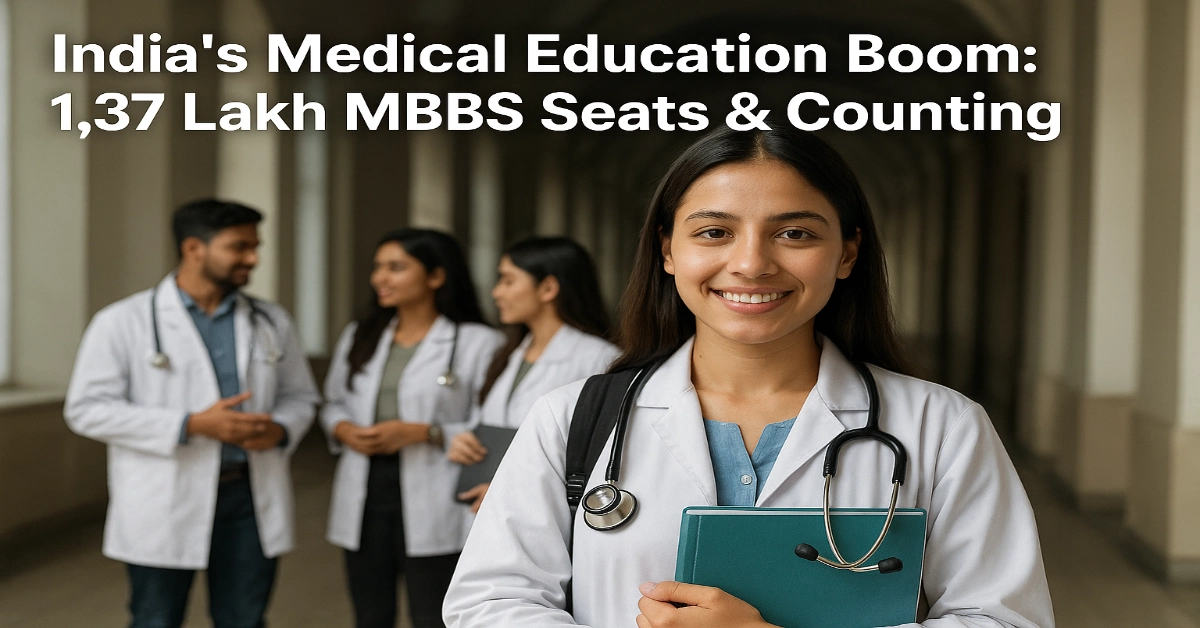Let’s take a moment to appreciate what’s happening right now in Indian medical education, because this is big.
For the first time in history, India has crossed 1,37,600 MBBS seats, spread across 816 medical colleges. Think about that. Barely a decade ago, we had less than half that number. Today, India stands at the cusp of becoming not just a “doctor-producing nation” but a global medical education powerhouse.
I still remember, just a decade ago, when parents would queue outside private medical colleges, struggling to afford ₹1 crore MBBS seats. Back then, studying abroad felt like the only realistic hope for middle-class NEET aspirants.
But today, India itself has become the land of opportunity for future doctors.
And this didn’t happen overnight. This surge is the result of an unprecedented push by the National Medical Commission (NMC), which has been quietly but steadily reshaping the country’s medical education ecosystem.
From expanding college capacity to approving new institutions, from research integration to regional equity, the transformation is nothing short of historic.
We can attest to the fact that “India’s medical education sector is witnessing an unprecedented transformation, with a historic rise in MBBS seats and new medical colleges across the country.”
NMC Expands Medical Education in India 2025: A Historic Leap
In October 2025, the NMC approved 10,650 new MBBS seats and 41 new medical colleges for the academic year 2024-25.
This single approval pushed India’s total to 1,37,600 MBBS seats, the highest in history. For comparison, in 2014, India had just about 54,000 seats, barely 40% of what we have now.
And this isn’t just a random surge. It’s a structured, policy-driven expansion, tied directly to Prime Minister Narendra Modi’s 2024 pledge to add 75,000 new medical seats over five years.
If you ask me, the government might hit that target two years early, by 2027, given the current pace.
What makes it all the more impressive is how inclusive this expansion has been. Instead of adding yet another college in Delhi or Mumbai, the focus has shifted to Tier-2 and Tier-3 cities, Bundelkhand, Vidarbha, Nagaur, Betul, Kakinada, places that were once educational deserts.
It’s not just about producing more doctors. It’s about placing medical education where healthcare is needed most.
A Policy Dream Taking Shape
Remember Prime Minister Narendra Modi’s 2024 pledge to create 75,000 new medical seats over five years?
Well, one year in, the country’s already a quarter of the way there. If the pace continues, India might hit that milestone well before 2029, possibly by 2027 itself.
That’s not just bureaucratic efficiency; it’s a reflection of political intent meeting regulatory agility.
Even Dr. Abhijat Sheth, NMC Chairperson, called this expansion a “regulatory milestone.” And for good reason, for the first time ever, all appeals against MARB (Medical Assessment and Rating Board) decisions were resolved without court intervention.
That’s rare harmony between institutions, and it signals maturity in India’s medical governance system.
But the story doesn’t stop at quantity. The NMC, in collaboration with the Indian Council of Medical Research (ICMR), is weaving research into the MBBS curriculum.
Future doctors won’t just diagnose, they’ll innovate, investigate, and perhaps even publish their first paper before finishing their internship.
Read Also: NMC Diwali Bonanza: 812 Medical Colleges & 1,26,600 MBBS Seats for NEET Aspirants
Behind the Numbers: The NMC’s Newfound Efficiency
The story of 2025 is really the story of how the NMC found its stride.
The year began with roughly 1,17,750 MBBS seats in May. Then, month by month, the numbers grew, first with provisional permissions, then renewals, and finally full-fledged new colleges. By mid-October, the count touched 1,37,600.
Let me quickly break it down:
- May 2025: Baseline of 1,17,750 seats.
- June-July: States like UP, Maharashtra, and Tamil Nadu submitted expansion proposals.
- August: NMC issued Letters of Permission (LOPs), adding about 2,000 seats.
- September: 7,075 new seats approved, total = 1,24,825.
- Early October: Another 9,075 seats added, total = 1,26,600.
- October 19: The big leap – +10,650 seats, +41 colleges → total 1,37,600.
I’ve been tracking these updates for years, and I can say confidently: this level of responsiveness and coordination from the regulator is unprecedented.
What’s truly fascinating is how data-driven this process has become. Every expansion was preceded by inspection, compliance checks, and an evaluation of district-level doctor density. It was strategic, deliberate, and aligned with the national health workforce plan.
The State-Wise Story: Who Gained the Most
Here’s where it gets interesting.
Some states have truly taken the lead in this expansion drive. According to the NMC’s October 2025 report:
- Uttar Pradesh: 1,100+ new seats across 5 colleges
- Maharashtra: 950+ seats across 4 institutions
- Tamil Nadu: 850+ seats across 3 colleges
- Gujarat: 800+ seats, with a focus on tribal regions
- Rajasthan: 700+ seats
- Karnataka: 650+ seats, mainly in private sector institutions
- Madhya Pradesh: 600+ seats in newly sanctioned government colleges
Collectively, these seven states account for over half of the national seat addition.
And that’s precisely the point, this expansion isn’t limited to a few regions. It’s broad, inclusive, and geographically distributed.
That means more doctors in smaller cities, more students studying closer to home, and eventually, better healthcare access in every corner of India.
The Human Side of Expansion: What This Means for NEET Aspirants
Every time I meet a NEET aspirant, I’m reminded that these numbers aren’t just statistics, they’re lifelines.
Now, let’s look at this from the perspective of a NEET aspirant.
For lakhs of students every year, the dream of becoming a doctor often collapses at the counselling stage due to limited seats and sky-high cutoffs.
But with 1,37,600 seats now available, and more coming soon, competition pressure will ease, at least slightly. More importantly, it opens up affordable government options in newer districts.
Last month, I spoke with a student named Payal from Hardoi, Uttar Pradesh. She told me how she’d lost all hope after missing a government seat by a few marks last year. Now, with new colleges opening in her own district, she has a shot again, without needing to go to another country.
That’s the real impact.
With every new college, thousands of students like Payal gain a second chance, and India gains a future doctor who might one day serve in a rural primary health center.
The Larger Impact: Healthcare, Equity, and Global Leadership
Let’s get in detail a bit. Why does this matter beyond the NEET counselling numbers?
Closing the Doctor-Patient Gap
India currently has about 7.2 doctors per 10,000 people, compared to 23.6 in Brazil and 26 in the UK.
With this expansion, India takes a concrete step toward bridging that gap, especially in rural public health systems.
Healthcare for All, Literally
The NMC’s focus on smaller districts is a quiet revolution. By placing colleges in tier-2 and tier-3 cities, we’re training doctors where patients live, not just in big metros.
The Research Leap
With ICMR’s collaboration, MBBS students will soon engage in clinical research and evidence-based learning. That means more innovation, better patient care, and perhaps India’s first homegrown Nobel in Medicine one day.
Economic and Social Mobility
Every new medical college is a local economy booster, from hostels and labs to hospitals and small businesses that thrive around them.
It’s not just education; it’s development to the core.
What the Experts Are Saying
“This is not just an expansion of numbers, but of opportunities. By 2030, India will have the most geographically distributed medical education network in the world.”
– Dr. Abhijat Sheth, NMC Chairperson
“Our goal is to produce doctors who are not only clinically sound but also socially responsible. Integrating research and AI will define the future of Indian medicine.”
– Senior ICMR Official (PTI)
For once, India’s medical education reforms are working in sync with its healthcare goals.
India’s Global Moment
If you zoom out, you’ll see that this transformation isn’t just about India, it’s about India’s place in the world.
We already produce more MBBS graduates annually than most countries. Now, with 1.37 lakh seats, India is on track to become the largest source of trained medical professionals globally.
External Affairs Minister S. Jaishankar recently said, “India will lead the AI transformation for the Global South.”
I’d argue that medical education is part of that same vision, an India that doesn’t just heal itself, but helps heal the world.
A Future Built on Data, Vision, and Determination
Here’s something we often overlook: each of these new seats isn’t just an academic approval; it’s a potential life saved in the future.
More seats mean more doctors. More doctors mean shorter wait times, fewer untreated cases, and more accessible healthcare, especially in rural India.
The NMC’s new regulatory culture, transparent, accountable, and proactive, signals that India’s medical education no longer needs foreign validation.
Instead of sending students abroad for MBBS in places like Costly Europe, Uncertain America, or War-torn Ukraine, India is building capacity at home, and doing it with quality.
But Let’s Be Honest: Challenges Remain
Of course, there’s another side to the story. Expanding so fast brings its own risks.
Every new college needs qualified faculty, hospital tie-ups, and clinical exposure. In some states, finding enough senior faculty remains a serious challenge.
Then there’s the question of quality control. The NMC has to ensure that the race for quantity doesn’t dilute standards. After all, producing 1.5 lakh doctors is impressive, but producing competent, compassionate doctors is what really counts.
Still, I’d say the signs are encouraging. The new digital inspection systems, transparent LOP process, and integration of research training all indicate that quality assurance hasn’t been forgotten.
Looking Ahead: The Road to 2029 and Beyond
If current trends continue, India could easily surpass 1.5 lakh MBBS seats by 2027, two years ahead of schedule.
The NMC has already hinted that new proposals for 2025-26 are under review, and the next application window opens this November.
That means even more opportunities for students, and a more robust healthcare pipeline for India’s growing population.
But the real milestone won’t just be the numbers. It’ll be when a student from a small-town college in Rajasthan or Assam graduates, practices locally, and helps transform her district’s healthcare.
That’s when this policy will have truly succeeded.
A Revolution Rooted in Hope
When I look at these numbers, 1,37,600 seats, 816 colleges, I don’t just see expansion. I see hope institutionalised.
- Hope for every student who once thought MBBS was out of reach.
- Hope for every village that’s never had a full-time doctor.
- Hope for a nation that’s finally aligning its education policy with its healthcare vision.
This is more than an academic reform. It’s a human revolution.
And someday, when a young doctor from a Tier-3 city saves a life in her community hospital, we’ll remember 2025 as the year when India didn’t just produce more doctors, it produced possibility.
Final Thoughts: A Dream Taking Shape
India’s 2025 medical seat expansion is not just an administrative update; it’s a national moment of pride.
We’re not just adding seats; we’re expanding dreams. We’re not just building colleges; we’re building capacity, capability, and confidence.
Every new medical college represents a new possibility, for a young student, for a village hospital, for a nation striving toward “Viksit Bharat 2047.”
And perhaps, years from now, when a young doctor from a Tier-3 town treats a critical patient in her community hospital, we’ll look back at 2025 and say, this was the year India changed its medical destiny.

